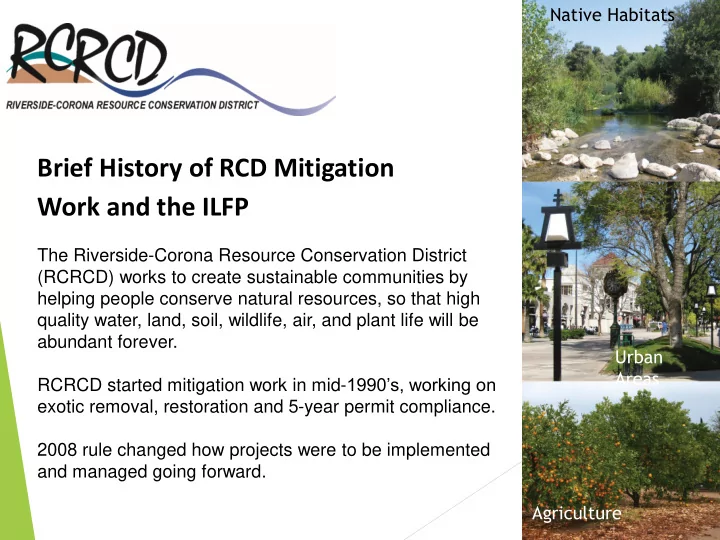

Native Habitats Brief History of RCD Mitigation Work and the ILFP The Riverside-Corona Resource Conservation District (RCRCD) works to create sustainable communities by helping people conserve natural resources, so that high quality water, land, soil, wildlife, air, and plant life will be abundant forever. Urban Areas RCRCD started mitigation work in mid- 1990’s, working on exotic removal, restoration and 5-year permit compliance. 2008 rule changed how projects were to be implemented and managed going forward. Agriculture
First ILFP in the ACOE’s Los Angeles District . ACOE LOS ANGELES DISTRICT
Riverside-Corona Resource Conservation District Riverside- Corona RCD’s ILFP: • Development of the ILFP initially was done by a resource inventory to determine potential sites. • Initially prioritized 21 different sites for potential restoration under the program including but not limited to alluvial scrub, alkali meadow, riparian and wetlands.
Prospectus for the In-Lieu Fee Program Prepared by the Riverside-Corona Resource Conservation District for the Army Corps of Engineers June 12, 2009
Site visits were made by the RCRCD team to determine acreage, conditions, threats, goals, historic aquatic losses, current aquatic resource and preservation objectives. It is critical to understand each particular site. The RCD’s restoration team then assessed current conservation and fee title lands under their control to determine which could be used. Research on purchasing lands vs. conservation easements – which is right for you?
If you are going to do an ILFP, you need to have competent staff : The RCRCD’s restoration team consists of a Natural Resources Manager, Habitat Restoration Specialist, Resource Conservationists, Biologist and some specialized assistance from the RCRCD’s Senior Plant Restoration Ecologist, Biological Resources Specialist, financial advisor, CPA, legal counsel and the District Manager. This team works to develop the 3 plans required under the ILFP: • The Development Plan • Interim Management Plan • Long Term Management Plan
The California Rapid Assessment Method (CRAM) is one of the tools used to determine buffer and landscape context; physical structure; hydrology; and biotic structure along with wetland delineation, soil analysis, drought conditions, etc.
• When program was set up the agencies that signed on to the program were ACOE, EPA and the Santa Ana Regional Water Quality Control Board (Interagency Review Team, IRT). • The IRT does invite other agencies on monthly calls such and the California Department of Fish & Wildlife and the U S Fish & Wildlife Service since they are not signatories to our ILF Program Instrument. • The RCRCD works closely with the IRT to obtain input and feedback on particular sites before they are submitted for an amendment to the instrument. • The RCRCD & IRT meet so the IRT is familiar with the types of credits available from our program. • Work with IRT to keep the process moving forward in a timely manner which lessens the delay in work due to weather conditions, endangered species and the migratory bird treaty act. • If you have concerns about whether the IRT will accept any particular project, consider sharing the potential project or site with the IRT before acquiring the land. Preliminary IRT sign-off can smooth the process when finalizing the development plans later.
Summer Winter Work is determined by season, conditions and species present.
Deleo ILF Property This site is a mix of alluvial scrub, riparian and upland habitat types.
Altfillisch ILF Property This site occurs in a major river floodplain and is wetland and riparian.
RCRCD collects local seeds and plant materials to ensure local genetic diversity for their restoration efforts. This should be considered and started immediately. Otherwise materials may not be available for purchase or you purchase from out of the region.
Administrative Challenges to ILFP mitigation • Site Selection – Before you acquire a site, the most critical item is to get is a title report to help determine if there are any potential red flags that would preclude the site from being used, such as old utility easements, structures and their maintenance (flood control), surrounding landuses, and that mineral rights have not been reserved or severed. • If you are partnering and using someone else’s land for mitigation be aware that once that property is approved and put into the program, the landowner will have a legally binding conservation easement that will limit their ability to use the land for conflicting values. • Knowing what it will cost to do the restoration and to come up with a realistic budget that will satisfy the IRT and allow you to do the work. Credit costs cover land acquisition (expensive in California), planting, other on the ground work, monitoring, perpetual management of the site, catastrophic events and other related costs.
Administrative Challenges to ILFP mitigation cont. • Prevailing wage vs Davis-Bacon Act: Check your local state to determine if federal laws or state laws for prevailing wage may be applicable for any contractors you hire. In California, prevailing wage laws make projects more costly than if you do them with staff • Fronting initial costs – this includes land purchase, due diligence, staff and legal costs. This could require you to advance these costs • Finding mitigation sites for non-ILFP partners such as California Department of Fish & Wildlife and US Fish & Wildlife Service • Permits – General NPDES Permit for Residual Aquatic Pesticide Discharges, Nationwide Permits, Regional General Permits, 401, 1600 and grading • Conflicting uses of restoration land: recreation, homeless camps, invasive animal and plant species, dumping, etc
Riverside-Corona Resource Conservation District QUESTIONS? Shelli Lamb lamb@rcrcd.org
Recommend
More recommend